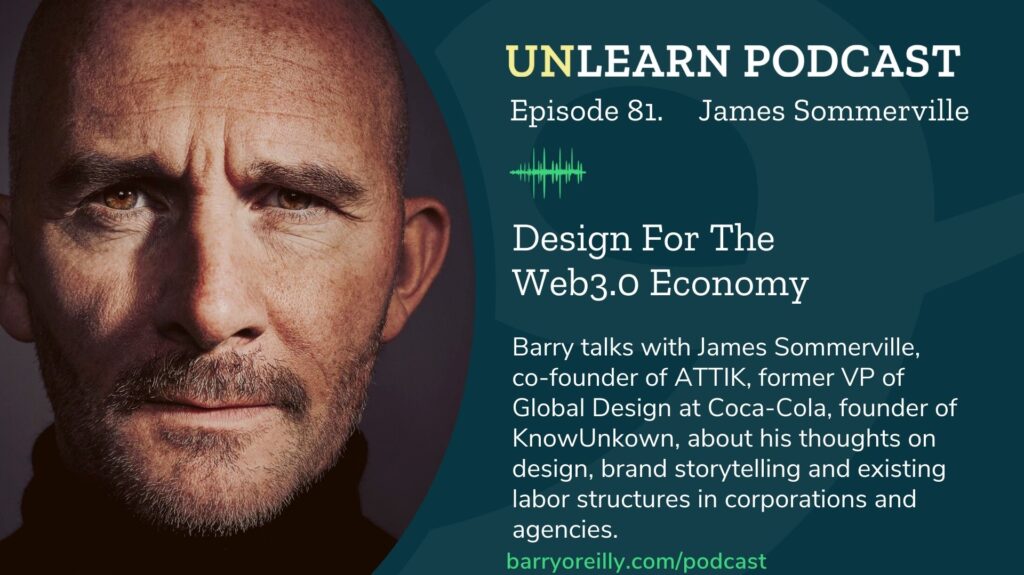In this episode “Design For The Web3.0 Economy”, Barry O’Reilly talks with James Sommerville, co-founder of ATTIK, the former Vice President of Global Design for The Coca-Cola Company and today founder of KnownUnknown, an emerging Web3.0 decentralized design community.
Sommerville talks about his entrepreneurial journey, from his early job as a street artist to co-founding ATTIK, a design studio with Simon Needham, and then becoming the Vice President of Global Design for Coca-Cola. He explains his thoughts on design, brand storytelling and existing labor structures in corporations and agencies, as well as the possibility for future advancements and new ways of working. He also discusses how these beliefs contributed to founding KnownUnknown.
The Long and Winding Road
James recounts his adolescent years in Huddersfield, west Yorkshire, UK, in the midst of the collapse of the city’s industrial peak. He believes that this experience led him to question society. “What led us here?” he asked. “What were the mistakes made? Maybe we need to learn what are the things we’re going to do differently.” His inquiring mind, and witnessing with his father’s entrepreneurial spirit – he saw how much freedom his father had over his own life outside of the constraints of a regular job – strongly inspired his thoughts on business. As a result, his road to KnownUnknown was filled with entrepreneurial endeavors, but his motivation has always been “that sense of being able to do something and make people smile.” [Listen from 2:25]

Put Yourself Out There
Putting yourself out there is the first step to success, James tells listeners. He describes his eventual employment with Coca-Cola as an unexpected reward that many people erroneously believed was overnight success. However, ATTIK had been in existence for 20 years before Coca-Cola contacted them. He believes that their strategy of “putting [themselves] out there, putting [their] signal into the world,” as Barry puts it, was the catalyst that led to such an exciting opportunity. This strategy yielded favorable results as one of their digital design publications, Noise, soon caught the attention of Coca-Cola. James remarks, “There’s something to be said about if you put your work into the world and people find it in the most unexpected and surprising ways… hold on to your authentic self, put your heart and soul into these things.” [Listen from: 8:40]
Work Within Constraints
“Working under constraints is one of my favorite aspects of great innovation,” James tells Barry. James admits he had to overcome some initial teething challenges, transitioning from operating independently at ATTIK to working for a major global brand. He quickly discovered that the need to stay true “the Coca-Cola way” but innovate how people worked in sharing the brand with the world. In order to thrive within these new boundaries, James had to unlearn ATTIK’s original mantra of thinking, looking, and acting big to “think small, act small, move like a small start-up.” This unlearning allowed them to see the product in a new light, resulting in new and imaginative concepts like using the Coca-Cola script to spell L-O-V-E and printing personalized labels. Barry comments, “One of the mantras of the book Unlearn is think big but start small, so you can learn fast what works and what doesn’t.” [Listen from 11:55]
Listen to this podcast on What it Takes to Build a Product-Led Organization with Yi-Wei Ang
Redefining the New Creative Economy
James’ reflections on the traditional design agency structure and newly available technologies led him to develop the KnownUnknown platform model – a new work environment in which gas community at the heart of the model, and regardless of geographic location, selecting the very best talents who tomorrow will have the freedom to choose their own hours and projects, free of the usual bureaucratic red tape.
Working at Coca-Cola put him on the client side of things, allowing him to see the industry from a different angle for the first time. He recognized that the current creative agency model encouraged individuation, making collaboration uncommon. “How can we give the talent an opportunity to work on known brands, known projects, known identities, and create a stage for this talent?” he asked. This reflection inspired him to rethink how this potential problem could be solved. “The notion of company starts to fade away,” Barry says, “it’s like projects that people want to work on and contribute to.” This encourages global collaboration without the red tape while also maintaining equity ownership, a significant departure from the old paradigm.
Job security, according to James, has been a fundamental impediment to the growth of decentralized entrepreneurship. He expects that there will be an eventual shift that allows individuals to perceive a portfolio type career as a viable option in the future. [Listen from 20:40]
Read this blog on How to Build a Portfolio Career for the Fractional Future of Work
Looking Ahead
“I’m really excited for the next decade,” James adds, as he prepares to “tiptoe” into the world of NFTs while experimenting with brand storytelling within metaverse and testing Web3 boundaries. He’s particularly excited about the expanded opportunities for brand and talent collaborations, where current and future designers, as well as centralized brands, can explore new developments. [Listen from 32:50]















